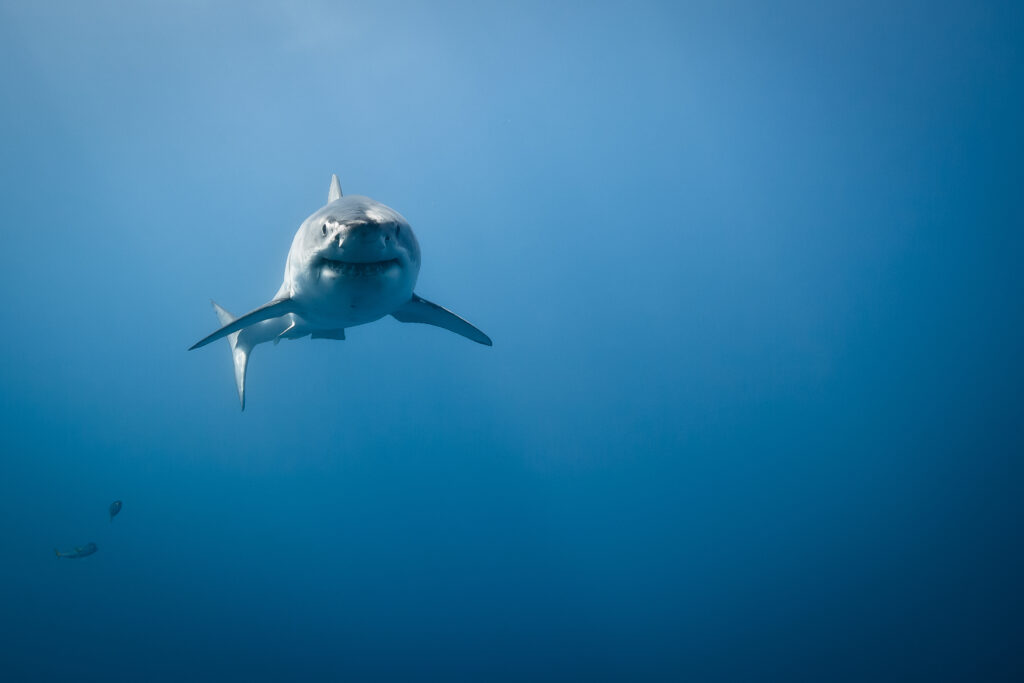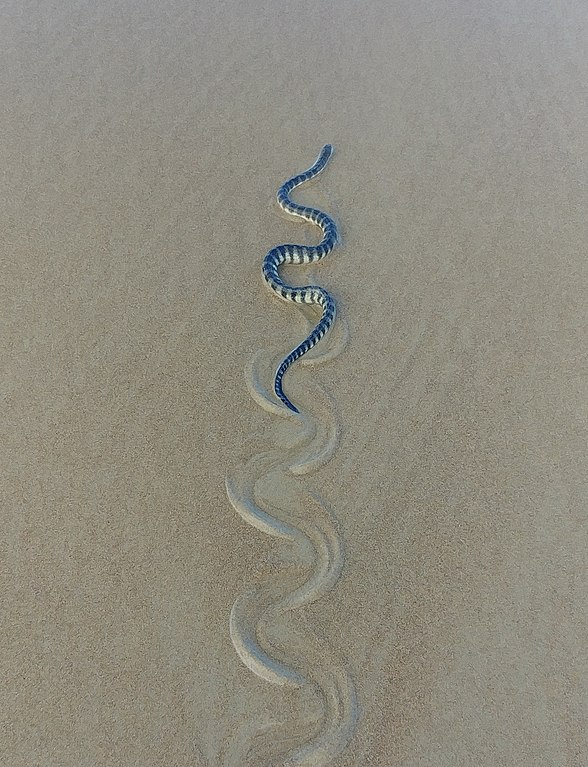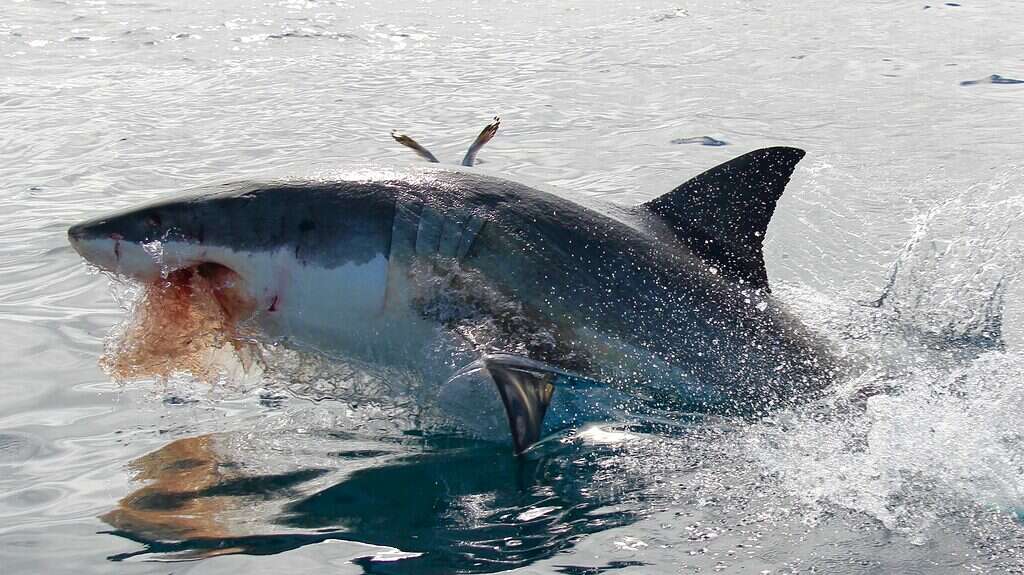Introduction
While the great white shark is one of the most terrifying and aggressive predators in the world, sea snakes are known to have the most potent venom compared to all other snake species, both on land and underwater. Thus, an epic battle between the two animals makes for an interesting match. The great white shark has few natural predators, but the sea snake can administer a strong neurotoxin that paralyzes its prey. Would the venom of 10 sea snakes be enough to take down one of the largest and strongest predators on Earth? Discover which animal would win in a fight and find out what threats they pose toward prey and human populations.
Background on the Great White Shark
The great white shark is feared by many animals and humans around the globe and throughout Earth’s oceans. Great whites are massive sharks with hundreds of sharp teeth that can easily rip apart their prey. In fact, the great white shark is one of the most dangerous animals in the world, and it is an apex predator. In media, the great white is often the animal chosen for thrillers like Jaws or the notorious Sharknado.
Great whites prefer temperate waters near the coast, and these waters often contain much aquatic life, which a great white can hunt for prey. Some countries whose coasts are home to great whites are the United States, Chile, New Zealand, Japan, and Australia. However, great white shark distribution extends outside these countries, too. Great whites may reside near Africa or Europe, and they might swim away from the coast or to tropical waters. Nevertheless, great whites will return to temperate zones to feed on prey.

Great white sharks may swim into the open ocean but return to the coast to feed.
©iStock.com/vladoskan
Great White Shark Appearance
This shark species is huge, measuring up to 21 feet in length and weighing between 1,500 and 4,000 pounds on average. However, some great whites have exceeded 5,000 pounds, though these are rare. The coloration of great whites is a combination of gray, dark blue, or brown usually arranged in a pattern, and they have a white underbelly. Great whites also have large muscles, which allow them to hunt and capture prey.
The great white has massive jaws with over 300 serrated teeth. The teeth of the shark are extremely sharp; they can easily slice flesh and even snap bones into little pieces. However, these teeth are secured in cartilage, rather than in bone. Thus, great whites can easily lose teeth over time. Some estimate that the great white may lose over 20,000 teeth in one lifetime. In addition, the shark maintains the second strongest bite force in the animal kingdom at 4,000 PSI, following behind the Nile crocodile, which has a bite force of 5,000 PSI.
The Sixth Sense of the Great White Shark
Unlike humans, great white sharks have six senses, as opposed to five. The animal maintains the same senses as humans, but its sixth sense is that of electro-reception. Electro-reception is the ability to sense an electrical field. Great whites can sense electrical currents in the ocean, which helps them to navigate Earth’s vast waters. In a way, electro-reception in sharks outlines a map based on electrical currents related to magnetic fields across the Earth’s crust. The map guides sharks in sensing where they are in the open ocean.
While the great white has excellent vision, taste, touch, and hearing, its strongest sense is that of smell. The species has an organ called the olfactory bulb, located underneath its nose. The olfactory bulb of the great white ranks as the largest of any shark in the world. This organ allows great whites to identify elements that measure around one part per 10 billion parts of water. Therefore, the great white can discover even the smallest amount of blood or biological fluid in the surrounding water, leading them to prey.

Electro-reception of the great white shark helps it to navigate.
©Jennifer Mellon Photos/Shutterstock.com
Dangers of Great White Sharks
Great white sharks are unarguably the most aggressive shark species on Earth. They are highly dangerous to both animals and humans. However, the great white does not hunt humans intentionally, unless they feel threatened. In most cases of a shark attack on a human, the great white has mistaken the human for prey, such as a seal. Great whites are usually looking for food when a shark attack occurs, and humans swimming or surfing in the water may appear like prey to the predator. Although, shark attacks are infrequent. Within the last 200 years, only 57 reported shark attacks on humans have resulted in death.
In addition, great whites have few predators. The main two predators of the species are humans and killer whales. Great white sharks also do not shy away from attacking species of sizes greater than themselves. For instance, great whites have attacked some whales in the ocean, according to several reports. Overall, the strength and aggression of the great white combine to create a fearsome predator, and almost no marine animals are safe from their jaws.
Background on Sea Snakes
The term “sea snake” encompasses approximately 60 different species of marine snakes that are venomous. All sea snakes belong to the cobra family, and there are two primary categories that sea snakes fall into. The first category is that of true sea snakes, and the second is sea kraits. While these creatures may not appear as terrifying as the great white shark, their venom is the strongest of all snake species on Earth. However, this animal is not aggressive and rarely encounters humans.
Like the great white, sea snakes are primarily found in waters along the coast. Oceans in which the sea snake is most prominent include the Indian Ocean and the western Pacific Ocean. They prefer waters that are less than approximately 100 feet in depth. One species of sea snake, though, resides in the open ocean near Africa and North and South America. This species is the yellow-bellied sea snake.
To find prey, most sea snakes slither along the seafloor or through coral reefs or mangroves. Every species also maintains a different preference for the type of seafloor. Some enjoy a hard bottom seafloor found in coral reefs while others look for prey around soft bottoms, which are characterized by the presence of sand and mud. The main prey of these snakes includes a variety of fish and eels. However, some sea snake species will only feed on fish eggs, and others prefer burrowing eels.

Sea snakes are some of the most venomous creatures on Earth!
©Nobu Tamura (http://spinops.blogspot.ca/) / Creative Commons – Original / License
Sea Snake Appearance
Since around 60 sea snake species exist, the features of the animal can vary greatly between them. Overall, though, the fangs of these creatures are not large, which reduces the amount of potent venom that they can release into prey. Most sea snakes measure between 3.3 and five feet in length. However, some sea snakes may reach a maximum of 8.9 feet long.
Generally, sea snakes look much like land snakes. However, the animals have small scales across their body that do not overlap, unlike some snakes on land. In addition, the scales of their underbelly differ between primitive and advanced species. Advanced sea snake species do not have scales on their belly and cannot crawl on land, but primitive species do have small scales underneath and can crawl. Perhaps the most interesting fact about sea snakes is that they breathe through their skin. This breathing pattern allows sea snakes to stay underwater for more than eight hours at a time.
Dangers of Sea Snakes
Sea snake venom is extremely dangerous and has a maximum toxicity rating measuring 0.044 mg/kg. The lower the toxicity rating, the more potent the venom of the sea snake is. The animal has neurotoxic venom, which, in essence, paralyzes the prey and breaks down its body. When neurotoxic venom is released into a victim through a sea snake bite, the venom immobilizes the prey. As the muscles fail to move properly, the respiratory system stops working.
In humans, the neurotoxic venom of a sea snake progresses gradually. At first, the bite will induce headache, swelling of the tongue, and vomiting. After these symptoms set in, paralysis will develop. The eyelids are the first part of the human body to become paralyzed after a sea snake bite. Then, the voluntary muscles will become immobile. Once paralyzed, the neurotoxic venom will break down the usage of the respiratory system.
Although, sea snakes are unlikely to attack humans. After all, the animal is not aggressive and will only bite a human if it feels that it is in extreme danger. Even then, the likelihood that a sea snake injects venom into a victim when biting is low. Reports of sea snake bites usually occur when fishermen accidentally catch a sea snake in a net. In this instance, the animal feels highly threatened and may bite in defense. On average, though, sea snakes will not approach nor engage with humans if they can avoid a conflict.

Some sea snakes are able to crawl on land.
©Vikramonice / CC BY-SA 4.0, via Wikimedia Commons – Original / License
Which Animal Would Win in a Fight: Great White or 10 Sea Snakes?
If a group of 10 sea snakes encountered a great white shark, they would likely be able to escape. If all of them could not escape, a few would evade capture. Great white sharks may consume sea snakes as a part of their diet. While not all sharks prefer to eat sea snakes, they may attack and consume one if they need food. However, the sea snake is a difficult catch for the great white shark. Sea snakes can swim quickly and can easily evade a great white shark.
However, some sharks have created a strategy for capturing sea snakes with ease. For instance, the bull shark circles around the sea snake until the snake has no escape route. Then, the bull shark will attack quickly and forcefully. On the other hand, tiger sharks will sit and wait for sea snakes near the seafloor. The tiger shark waits close to the area where sea snakes often go for shelter. Once the sea snakes have entered the area, the tiger shark will attack. Both shark species will bite into the sea snake and rip it apart before swallowing it.
In the case of the great white, this shark is likely to simply swallow a sea snake in one gulp. Since the great white is extremely large, it may not need to chew up the sea snake before finishing it as a meal. If the great white shark employed the tactics of the tiger and bull shark, it would likely find even more ease in attacking sea snakes.
While 10 sea snakes could evade capture by the great white shark, they would not win in a physical fight. While the venom of the sea snake is some of the most potent in the world, the snake is not aggressive enough to attack the great white. In addition, the snake’s fangs are extremely short and may not inject enough venom to take down the beast. With the combination of 10 sea snakes, they still would be unable to inject venom before the great white began to attack. While some snakes might escape, it’s likely that the great white would catch a few and swallow them down. Overall, the great white shark has the advantage of bite force, strength, and hunting skill over the sea snake, making the great white the victor in this epic battle.

As an apex predator, the great white shark would defeat 10 sea snakes.
©Nicholas Ferbert/Shutterstock.com
Thank you for reading! Have some feedback for us? Contact the AZ Animals editorial team.








